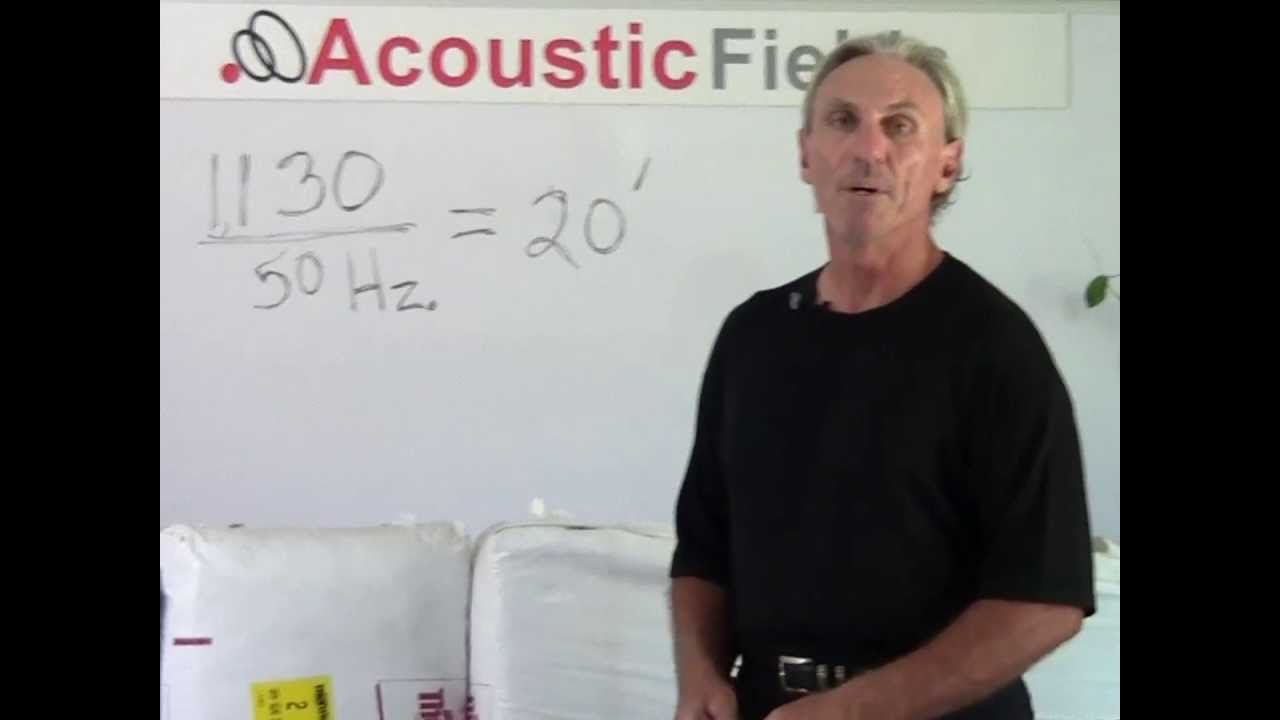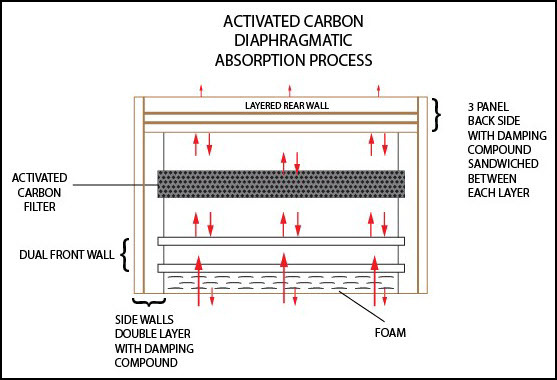If you are looking for a bass absorption solution that actually tackles the low frequency problems in your studio there really is only one way to go. Diaphragmatic absorption is the most powerful low frequency absorption option in the marketplace. It has been time tested and proven in recording studio builds all over the world. It is the go to absorbing technology for the recording studio build market and it has been around for over 40 years. And in this video I explain why it really is the best bass absorption option available to you right now and how it works.
As explained in the video it is a sealed unit that does not need holes for air to go into the unit and be absorbed. Diaphragmatic absorption is for low frequency energy absorption and low frequency energy, less than 100 Hz., has real long waves. A 30 Hz. wave is 37′ long and has a height and width. It can go through almost anything, including the earth. It does not need an air hole as an invitation to be enter the cabinet to be absorbed.
Bass Absorption – All Sounds Heard
You know that sound in your room when you play or record your music and the kick drum or electric bass slams through. You know the sound you want to hear. You want to hear the strike of the drum head for the attack and then the note decaying on its own volition throughout your room and especially at the listening or monitoring position. You also need to hear the background singers harmony which is three parts in total and you must hear each part without any blurring or smearing of those frequencies by the excess bass energy in your room. You need to call in the heavy artillery for this defining of each layer of your music recordings and playback systems.
Diaphragmatic Absorber – 3 Parts
A diaphragmatic absorber has three main parts. The cabinet, the front wall, and the internal cabinet fill material. The cabinet is rigid and forces the front wall, which is not as dense and rigid, to start moving when a low pressure wavelength strikes it. Once the wavelength strikes the front wall it is slowed down by a margin and percentage based on the front walls density and ability to move correctly. Once slowed down, the wavelength then enters the cabinet inside where it meets a small room.
Internal Cabinet
Inside the cabinet is a small room that has a certain width, depth, and length. This “room” holds the internal cabinet fill material. The fill material must do two things well. First, it must absorb the internal room resonances completely. the internal cabinet resonances must not be allowed to make any sound of their own. Secondly, it must act in a manner that contributes to the overall performance of the diaphragmatic absorber and increase the absorbers level and the rate of absorption. The cabinet depth determines the lowest level of absorption that the unit can support and the internal cabinet fill material determines the rate of absorption from the unit’s resonant frequency or beginning absorption frequency.
Cabinet Fill Material
If you choose the cabinet fill material correctly, you can achieve rates and levels of bass absorption usually only reserved for a full studio ground up build. In order to achieve the horsepower provided by diaphragmatic absorption, you would have to build normal walls in the studio that were much deeper than conventional construction methods to achieve the same or similar absorption results as a carefully constructed freestanding diaphragmatic absorber. Pound for pound and size for size, you just can’t find a more powerful low frequency or bass absorber.
Summary
I hope you have enjoyed this explanation. Please leave any comments below so I can get back to you. Don’t be afraid to hit those Facebook like, Google+ and Twitter buttons on the left hand side so other people can see this post. And if you want to learn more about this subject please sign up for our free room acoustic treatment videos and ebook which provide step by step instructions. Get instant access by signing up now.
Thanks
Dennis









Hi Dennis, what you are saying trhough this vídeo is that in order to absorb 100% of certain frecuency you need as depth as the wavelenght is?. I mean, doesnt it depends on the material?
Luis.
Hi Luis,
Each absorption material type has a rate and level of absorption. The rate is how much it absorbs at what frequency. The level is how low in frequency the material is able to absorb at. The material type may absorb 100 % of the energy at 100 Hz. for the surface area represented but to actually have 100 % absorption of any wavelength within a small room environment, you must have that physical dimension to work with. Windows are 100 % absorbers because sound leaves and never comes back.
Good question.
Dennis
These are broadband absorbers, not tuned to any particular freq, but will absorb above a certain lowest freq depending on unit depth, if I got this right?
Hi James,
The resonant frequency or lowest frequency of absorption of the cabinet is determined by a marriage of cabinet depth, cabinet density, and front wall(diaphragm) density. It is a synergy of these three variables that determines the cabinet resonant frequency. Frequencies above the resonant frequency will be absorbed, those below will not.
Managing those three variables will produce designed for resonant frequency. The internal cabinet fill will produce a certain rate of absorption at that designed for resonant frequency level. You can design for a broadband approach which covers multiple frequencies or a more frequency specific approach.
Our ACDA-10 is a broadband absorption unit from 30 – 400 Hz. Our ACDA-12 is more frequency specific from 30 – 50 Hz. If you compare like surface areas, of membrane, Helmholtz, and diaphragmatic absorption units, diaphragmatic is the most powerful of the three.
Dennis
Hello, Dennis,
I am interested in your DIY Build Plans Bundle to build my own absorbers and diffusers. I have one question: Does the diaphragmatic absorber manual have the instructions to build the absorber according to the frequency one wants to treat, or does it only tell you how to build only one, broadband absorber? Thanks in advance.
F, The ACDA-12 is 30 Hz. – 50 Hz. The ACDA-10 is 30 Hz. – 300 Hz. If you place a foam on the face you extend to 6,300 Hz. using our foam.